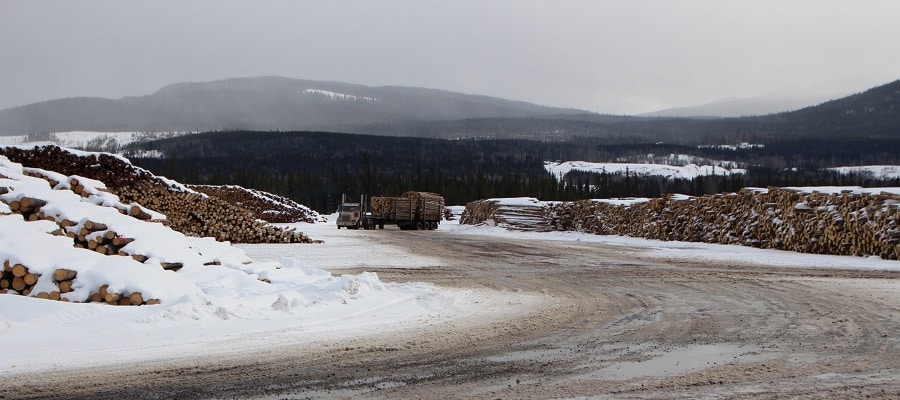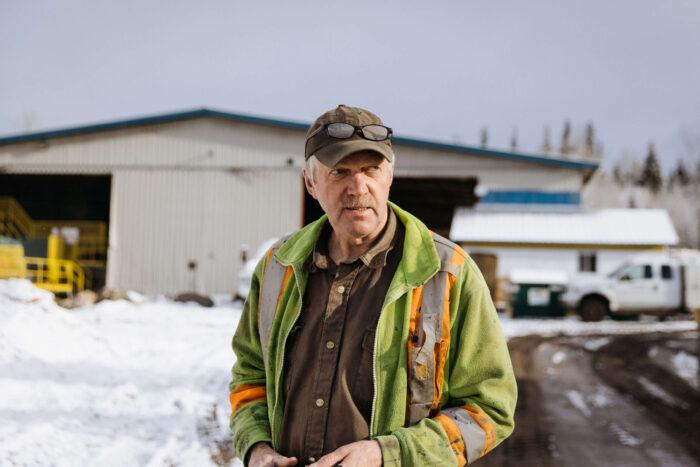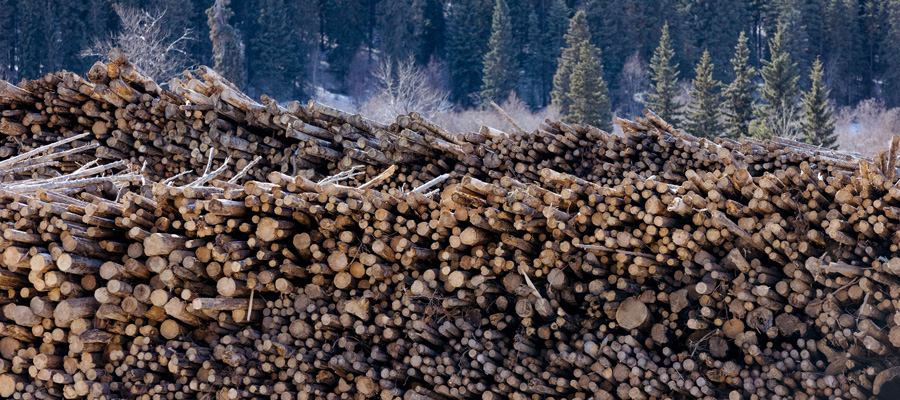Houston Falling: Super-sized mills lead to super-sized problems for BC forests and workers

When the world’s biggest sawmill opened its doors, then-premier Gordon Campbell enthused that it could shoot out enough lumber to build all of British Columbia’s new annual housing stock, which was then averaging 26,000 units per year.
After the ribbon was cut and the first logs passed through its computerized scanners and whirring sawblades on February 9, 2004, its owner claimed it might produce 600 million board feet a year—25 per cent more than its closest global rival, a lumber mill in Germany.
But just 20 years later, the super-sized mill is set to close, another casualty in a province and industry that went all in on bigger is better and now lives with the consequences.
Located in Houston, a three-and-a-half hour drive west of Prince George, the jumbo mill is owned by Canfor, a company that has made headlines in recent weeks—but not for ribbon cutting.
On January 11, the company notified 300 pulp mill workers in Prince George that their jobs would soon be gone. Then on January 25, Canfor announced it was permanently closing a sawmill and wood pellet mill in Chetwynd and indefinitely closing its super-mill in Houston.
The latest mill closures will result in the loss of nearly 500 of some of the highest-paying jobs in two communities with populations of roughly 3,000. Other job losses will likely follow.
“A wholesale slaughter”
Bob Simpson, who for many years was mayor of Quesnel and before that a provincial MLA and one-time forestry critic, says in the communities where mill closures have been announced a “wholesale slaughter of family incomes is now underway.”
And the tragedy is, people could foresee 20 years ago that the slaughter was coming.
The day after operations commenced in Houston on February 9, 2004, the Globe and Mail’s Peter Kennedy reported that the new super-mill posed risks.
Smaller mills were going to find it “increasingly difficult to get raw logs for processing,” he wrote. And the squeeze wouldn’t come just from one super-mill.
“These mills,” Canfor’s then-CEO David Emerson prophesied using the plural, “are part of our future in British Columbia.”
That future would be dominated by big companies that, like Canfor, had access to the capital needed to build super-mills, had amassed licences to log vast stretches of BC’s forests, and whose prodigious lumber output allowed them to reliably supply big box retailers in the US like Home Depot and Lowes.
The stars align
Houston’s super-mill arose out of a $26.4-million retrofit of an existing mill.
New computer technology was deployed to guide how logs were scanned and then cut to maximize the amount of lumber recovered.
The upgrades also ensured that production at one or more of the mill’s four lines could be quickly readjusted to produce different dimensions of lumber should demand for specific kinds of boards arise.
Overall, the investments reduced the costs of logs processed at Houston by 24 per cent—a significant achievement in any industry that produces commodities. Canfor’s rivals didn’t stand idly by. Before long, West Fraser, Tolko, Carrier and Dunkley all did the same thing.
What emerged, as captured in provincial government reports, were eight super-mills that between them produced enough lumber each year to circle the Earth more than 24 times.
The arrival of the super-mills was propitious. A beetle outbreak had surged across a wide expanse of the province, killing tens of millions of lodgepole pine trees.
In response, the government allowed logging companies to vastly increase the number of trees they cut down each year. The thinking then was to extract the value from the dead pine trees quickly, before they deteriorated too much and became unusable for lumber.
What emerged were eight super-mills that produced enough lumber annually to circle the Earth more than 24 times.
In the forest, the accelerated logging was mostly done in highly mechanized operations where one person sitting in the cab of a feller-buncher machine moved steadily through the forest grabbing one tree after another, cutting them at the base and throwing them to the side—operations that displaced the work once done by numerous hand-fallers or loggers.
The felled trees were then trucked to highly automated sawmills where because of the technology deployed, many more logs were needed to support each mill job.
What ensued was a form of strip-mining. And it wasn’t just dead pine trees that fell, but healthy trees as well—a pattern later repeated when another pest, the spruce bark beetle—started killing some, but by no means all, of the spruce trees.
“Unfortunately,” Simpson says, “logging during the spruce beetle outbreak led to so many good spruce trees coming down that it further eroded the forests and deepened the mid-term timber supply crisis now enveloping the lumber industry.”
That crisis has translated into a slew of mill closures. When the Houston super-mill opened there were 194 large, medium and small sawmills in BC. By 2020, that number was almost halved and stood at just 111 mills.
No company escaped unscathed including Canfor. In 2004, it operated 16 sawmills in BC. With the pending closures in Chetwynd and Houston, it will be down to just seven.
Meanwhile, the company has purchased numerous sawmills in Alabama, Arkansas, Georgia, Louisiana, Mississippi and North and South Carolina—southern US states where planted trees grow in a fraction of the time they do in BC and where workers’ wages and benefits trail behind those here.
The rocky road ahead
Jeff Bromley, chair of the United Steelworkers Wood Council, said it has been a fact of life in the province since the late 1980s that “more fibre is being produced with less people.”
But he also says the pain felt by rural communities has been exacerbated by provincial governments that retreated from the idea that trees taken from publicly owned forests should be turned into forest products close to where they were logged.
For decades this was government policy, before being scrapped by the Campbell government around the time that the Houston super-mill came into existence and smaller sawmills began to be outcompeted for wood resulting in a rash of closures.
With that policy abandoned, Bromley says companies closed mills and moved logs greater distances.
“You could truck wood from Fort Nelson to Fort St. John. You could truck it way longer distances,” Bromley says. “That’s just the reflection of the industry today. The hauls are longer and longer. I’ve heard about hauls now of 15 hours.”
Bromley says there is some hope that Canfor may invest in a new mill in Houston at a projected cost of $200 million. But an investment of that magnitude will require approval by the company’s board of directors, a decision that won’t come until at least the late spring.
If the project does proceed, Bromley says it will likely be two years before a portion of the unionized workers who lost their jobs in Houston are back working again. According to Canfor, if the new mill is built it will produce higher value products but use less raw material to make them.
Bromley says while it’s “obviously a good thing to get more out of the resource,” workers in value-added facilities frequently don’t receive the higher wages, pensions and benefits that his union’s members enjoy in the mills where they work. Bromley stresses that a lot of high-value products are already made in those mills.
“I maintain that if the industry shifts in that direction, it should be with union workers,” he says.

Andy Thompson, owner of a small Bulkley Valley sawmill, employs 24 workers who turn trees that used to be burned as waste into large pieces of lumber known as cants, which are then turned into higher value products at a second mill in Port Alberni. Photo Credit: Marty Clemens.
Where are the innovators?
As the former mayor of Quesnel, Simpson presided over a community with one of the highest per capita levels of forest industry investment in BC. Two pulp mills, a number of sawmills and other processing facilities including a value-added mill and wood pellet facility are all in or near town.
Simpson says Canfor should not be allowed to do in Houston what it did 18 years ago in Fort Nelson. In 2005, Canfor closed two panel mills in the community and 600 people lost their jobs.
Yet Canfor continued to hold its government-granted logging licence—even though the community asked the provincial government to take it back.
A little more than two years ago, Canfor finally sold its Fort Nelson forest licence to Peak Renewables, a company headed by Brian Fehr, a businessman with longstanding ties to Canfor.
Peak proposes building what would be the largest wood pellet mill in Canada in Fort Nelson. It’s a move that the United Steelworkers, Unifor and the Public and Private Workers of Canada—all of which represent forest industry workers—characterize as bad for both forest industry employment and the climate.
As few as 60 people would work in the proposed pellet operation, which would require roughly 1.2 million cubic metres of aspen trees to be chopped down every year to supply it—a not dissimilar amount of wood to the huge number of logs consumed at the Houston super-mill which, while heavily automated, employs five times as many people.
The pellet mill has yet to materialize, however. In the meantime, small amounts of logs are once again coming out of Fort Nelson’s forests. But what is coming out is trucked 400 kilometres south to Fort St. John, where Canfor among others operates.
As few as 60 people would work in the proposed pellet operation.
Simpson says Houston should not suffer a similar fate.
“The provincial government has to answer the question: If Canfor is not going to be the innovator in Houston, who can be?”
The list of possible innovations runs deep, Simpson says, and includes:
- Working with hardwood trees like alder and aspen, trees that historically were treated with such contempt by the industry that they were often cut down and burned.
- Making more engineered wood products that can compete with steel in some cases and that can be made from younger trees not from the trees in older forests.
- And a wider array of pulp mill products including “bioplastics” made of wood, not oil, asphalt additives that replace bitumen, or heat captured from such mills and then used in centralized, community heat distribution systems.
Simpson cautions that none of this will happen quickly.
“You can’t just say we’re going to stop doing this tomorrow and start doing that the day after,” he says. But it can happen.
He cites as one example the recent announcement by Paper Excellence that it will invest roughly $30 million and another $20 million from the federal and provincial governments to reopen a paper line at the Vancouver Island mill. The line is slated to make water-resistant papers that can be used to make products that replace one-use plastics.
An antidote
The Seaton Forest Products mill is located just over a half hour’s drive north of Smithers along the Yellowhead highway.
Four-fifths of the mill’s 24 employees are Gitxsan or Wet’suwet’en Nation members, many of whom live a short distance away in the community of Witset.
At a quick glance, what Seaton does with its logs may seem unremarkable.
The mill cuts the round edges off two sides of each log, then flips each log a quarter turn and cuts the remaining round edges off. What’s left are big rectangles of rough-cut wood called cants, which are then shipped to other mills for further processing.
But it’s the logs that Seaton works with that makes it unique. Almost all of its logs come from trees that are dead and many of them also have defects. As a result, they are typically rejected for use by the companies that operate the region’s large sawmills.
In years past, that rejection meant one thing: the dead trees that were logged were pushed into piles along with the slash and other debris at logging sites and burned.
By working with the region’s major forest companies including Canfor and West Fraser, as well as with smaller logging contractors, Seaton’s owner Andy Thompson convinced them to separate the dead logs into special sorts so they could be trucked to his mill instead of being burned.
More from less
Until last year, Thompson says, most of the cants made at Seaton were shipped from Prince Rupert to China where they were re-cut. But in January 2022, Seaton entered into a supply agreement with the San Group, which had invested more than $100 million to build a new high-value processing plant in Port Alberni.
Significantly, that investment was the first involving a new mill on BC’s coast in decades and is in a community where ocean freighters routinely arrive to take away tens of thousands of unprocessed raw logs at a time from a province that still exports millions such logs each year.
Some of the highest value products made by the San Group involve re-cutting Seaton’s cants, then laminating them with veneers (thin cuts) of coastal red cedar which vastly increases their value.
Each year, Seaton requires about 80,000 cubic metres of logs to keep its workers employed, meaning that for each job at the mill roughly 3,300 cubic metres of logs must be found. At the Houston super-mill by comparison, half as many logs again are needed to sustain each mill job.
Not only is Seaton creating more jobs with less raw material, but the cants it produces are then remanufactured at another BC mill, further increasing the number of jobs generated per unit of wood processed.
“To me, it’s a no-brainer. The government says it wants to see more value-adding in our province. It also says it wants to see more First Nations people working in resource industries. Well, we’re doing both right here,” Thompson says.
The way to make sure that continues is to turn more natural resources like forests directly over to First Nations—something the government also says is a priority.
Thompson believes if that happened in the Bulkley Valley, members of the Witset First Nation would be only too happy “to hitch our wagon” to their licence.
The Witset First Nation would control the logs and a good portion of those logs would move to a mill where its own members worked.
It would be something of a return to the days before the super-mills, when local forests were meant to provide benefits to local communities and government policies explicitly said that should happen.
Topics: Environment, resources & sustainability, First Nations & Indigenous


